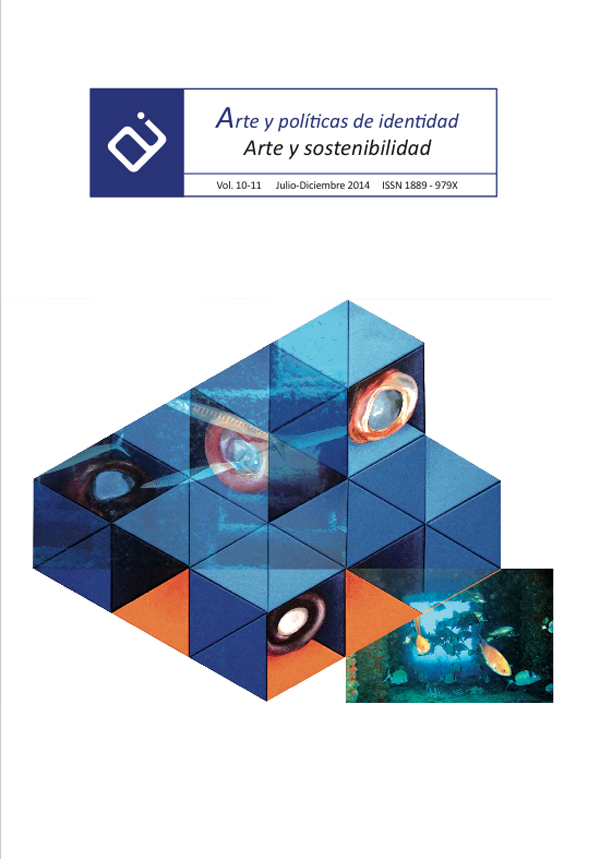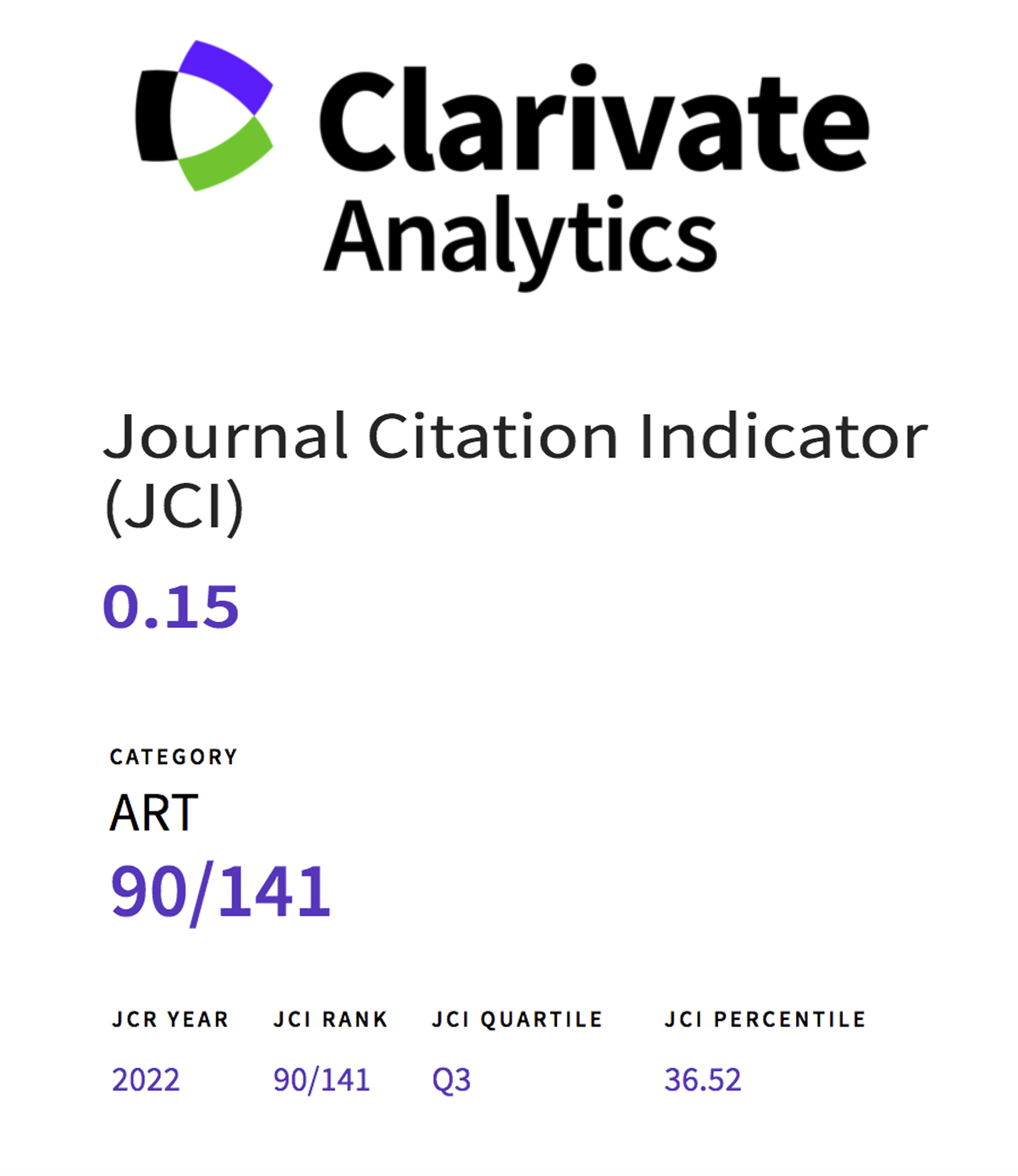Ecological Art Practices: a State of the Art
Abstract
For two decades we are attending the rise of social, economic, political and identity conflicts, issues involving dichotomous relationships established between nature and culture. These issues have been discussed both politically and epistemologically from different disciplinary fields of knowledge and processes. In this sense, artistic practice has shown a particularly active role. Due to the proliferation, diversity and importance of their contributions, the purpose of this article is to develop a state of affairs that shows the terms in which, from the sixties, certain artistic practices coincide contain the concept of ecology as a constant feature, in order that models of “development” alternative to the modern paradigm, based on different value systems and knowledge, begin to gain more strength socially.Downloads
References
Andrews, M. (2006). Land Art. A Cultural Ecology Handbook. Manchester: RSA. Arts Council.
Bal, M. (2005[2002]). Conceptos viajeros en las humanidades. Estudios Visuales, 3, 27-77.
Blanc, N. (2008). Vers une esthétique environnementale. Paris: Quae.
----- (2012). From Environmental Aesthetics to Narratives of Changes. Contemporary Aesthetics. [En línea] [Fecha de consulta: 5/5/2013] <http://www.contempaesthetics.org/newvolume/pages/article.php?articleID=655>
Blanc, N., Ramos, J.(2010). Écoplasties. Art et Environnement. Paris: Manuella Editions.
Bonacossa, I., Latitudes (2008). Greenwashing. Environment: Perils, Promises and Perplexities. Texto del catálogo de la exposición Greenwashing. Environment: Perils, Promises and Perplexities. Turin, Fondazione Sandretto Rebaudengo (febrero-mayo 2008): The Boomakers.
Bower, S. (2010). A Profusion of Terms. [En línea] [Fecha de consulta: 12/04/2011] <http://greenmuseum.org/generic_content.php?ct_id=306>
D’Angelo, P. (2001). Estetica della natura. Belleza naturale, paesaggio, arte ambientale. Roma-Bari: Editori Laterza.
Demos, T. J. (2013). Contemporary Art and The Politics of Ecology. Third Text. Critical Perspectives on Contemporary Art &Culture, 120-27, 1-9.
Dobson, A. (1997). Pensamiento político verde: una nueva ideología para el siglo XXI. Barcelona: Paidós.
Escobar, A. (1999). El final del salvaje: naturaleza, cultura y política en la antropología contemporánea. Santafé de Bogotá: Instituto Colombiano de Antropología, Centro de Estudios de la Realidad Colombiana.
----- (2003). Mundos y conocimientos de otro modo. Tabula rasa, 1, 51-86.
Felshin, N. (2001[1995]). ¿Pero esto es arte? El espíritu del arte como activismo. In Blanco, P. et alii (Eds.), Modos de hacer. Arte crítico, esfera pública y acción directa (pp.73-94). Salamanca: Universidad de Salamanca.
Goñi, R., Goin, F. (2006). El desarrollo sustentable en tiempos interesantes. Contextos e indicadores para la Argentina. La Plata: Scalibrini Ortiz.
Guattari, F. (1990 [1989]). Las tres ecologías. Valencia: Pre-Textos.
Kagan, S. (2011). Art and Sustainability. Connecting Patterns for a Culture of Complexity. Bielefeld: Transcript Verlag.
Kastner, J.,Wallis, B. (2005[1998]). Land Art y Arte Medioambiental. New York: Phaidon Press.
Lacy, S. (1995). Mapping the Terrain. New Genre Public Art. Seatle, Washington: Bay Press.
Lander, E. (2000). Ciencias Sociales: saberes coloniales y eurocéntricos. In E. Lander (Ed.), La colonialidad del saber: eurocentrismo y ciencias sociales: perspectivas latinoamericanas(pp.4-23). Buenos Aires: CLACSO.
Laville, B., Leenhardt, J. (1996). Villete-Amazone. Manifeste por l’ènvironnement au XXI siécle. Texto del catálogo de la exposición Villete-Amazone. Paris, Grande Halle de la Villette (octubre-noviembre 1996): Babel.
Lippard, L. (1980). Sleeping Exchanges: The Contribution of Feminism to the Art o the 1970s. Art journal, 40:1-2:362-364.
Matilsky, B. (1992). Fragiles Ecologies. Contemporary Artists’ Interpretations and Solutions. New York: Rizzoli.
Mignolo, W. (2010). Desobediencia epistémica: retórica de la modernidad, lógica de la colonialidad y gramática de la descolonialidad.Buenos Aires: Ediciones del Signo.
Miró, N. (2000). Formas artísticas en la reivindicación de la naturaleza. Arte ecológico. In Perán, M.; Picazo, G. (Eds.), Naturalezas. Una travesía por el arte contemporáneo. (pp. 253-278). Barcelona: MACBA.
Mouffe, C. (2007). Prácticas artísticas y democracia agonística. Barcelona: Museu d’Art Contemporani de Barcelona, Universitat Autònoma de Barcelona.
Nordhaus, T., Shellenberger, M. (2004). The Death of Environmentalism. Global Warming Politics in a Post-Environmental World. [En línea] [Fecha de consulta: 16/7/2011)< http://www.thebreakthrough.org/images/Death_of_Environmentalism.pdf>
Parreño, J. M. (2006). Naturalmente Artificial. Texto del catálogo de la exposición Naturalmente artificial. Arte español y naturaleza 1968-2006. Segovia: Museo de Arte Contemporáneo Esteban Vicente (septiembre-diciembre 2006): Museo de Arte Contemporáneo Esteban Vicente.
Pérez de Lama, J.(2009).Guattari no cesa de proliferar. Arte como máquina ecosófica [En línea] [Fecha de consulta: 16/10/2011] <http://hackitectura.net/osfavelados/2009_proyectos_eventos/200911_guattari_macba/200911_presentacion_macba_guattari.pdf>
Ramade, B. (2007). Mutation écologique de l’art?. Cosmopolitiques, 15: 31-42.
Riechmann, J. (1994). Redes que dan libertad. Barcelona : Paidós.
Smith, S. (2006). Beyond Green. Texto del catálogo de la exposición Beyond Green. Toward a sustainable art. Chicago, Smart Museum of Art, University of Chicago (octubre 2005-enero 2006), New York, Museum of Arts and Design (febrero-mayo 2006), Cincinnati, contemporary Arts Center (mayo-julio 2007), Indiana, Richard E. Peeler Art Center, DePauw University Art Museum (septiembre-diciembre, 2007): David an Alfred Smart Museum of Art, Independent Curators International.
Spaid, S. (2002). Ecovention. Current Art to Transform Ecologies. Cincinnati: greenmuseum.org, The contemporary Arts Center, ecoartspace.
Strelow, H. et alii (eds.) (2004). Ecological Aesthetics: Art in Environmental Dessign: Theory and Practice. Basel: Birkhaüser Verlag für Architektur.
Tiberghien, G. (2001). Nature, Art, Paysage. Arles: Actes Sud. École Nacional Supériere du Paysage. Centre du Paysage.
Villa, M. (2006). Arte emergente en España. Madrid: Vaiven.Weintraub, L. (2006). EcoCentric Topics: Pioneering Themes for Eco-Art. Nueva York: Artnow Publications.
----- (2007). Cycle-Logical Art: Recycling Matters for Eco-Art . Nueva York: Artnow Publications.
----- (2007). EnvironMentalities: Twenty-two Approaches to Eco-Art. Nueva York: Artnow Publications.
----- (2013). To life! Eco Art in porsuit of a Sustainable Planet. Berkeley- Los Angeles-London: University of California Press.
Works published in this journal are subject to the following terms:
- The Service of Publications from the University of Murcia (publishing house) keeps the published works’ copyrights, and favors and allows the reuse of these works under the license indicated in point 2.
- Works are published in the journal’s online edition under the license Creative Commons Reconocimiento-NoComercial-SinObraDerivada 3.0 España(texto legal). They can be copied, used, disseminated, transmitted and publicly exhibited, as long as: i) the author and original source of publication are cited (journal, publishing house and work’s URL); ii) they are not used for commercial purposes; iii) the existence and specifications of this license are mentioned.
3. Conditions for auto-file. It is allowed and encouraged that authors share electronically their pre-print version (the pre-reviewed version) and /or post-print version (the reviewed and accepted version) of their Works before the publication, since it promotes its circulation and dissemination. RoMEO color: green.









